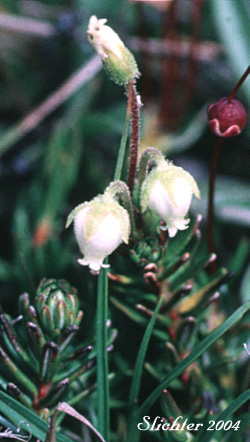
 The
photo at right shows the shiny, glabrous leaves as well as the flowers and glandular
pedicels and sepals of yellow heather as seen high at Bird Creek Meadows at the
southwest corner of Mt. Adams.........September 1, 1996.
The
photo at right shows the shiny, glabrous leaves as well as the flowers and glandular
pedicels and sepals of yellow heather as seen high at Bird Creek Meadows at the
southwest corner of Mt. Adams.........September 1, 1996.
Also known as yellow mountain-heather, cream mountain-heather or white heath, yellow heather is a perennial wildflower with erect to decumbent, much branched stems from 10-40 cm high. The numerous leaves are 7-10 mm long and are oblong to obovate in shape with the margins rolled inwards toward the upper side, which effectively makes the leaves appear narrower than they are. The lower surface of the blades are densely glandular while the upper surface contains stiff hairs as well as gland-tipped hairs.
The inflorescence is subumbellate and consists of 3-7 flowers. The pedicels, calyx and corolla are all densely covered with hairs and glands. The pedicels are 6-10 mm long while the calyx lobes are lance-ovate in shape with acute tips. The pendant corolla is pale yellowish or cream in color and urn-shaped. The corolla is widest near its base, tapering gradually toward the tip which has 5 short, spreading lobes which are ovate-lanceolate in shape (See photos above and at right.). The style is included within the corolla while the filaments are pubescent and the anthers about 1 mm long. This species may hybridize with P. empetriformis when plants of both species are in close proximity to one another.
Yellow heather may be found in meadows and clearings near timberline and upwards into the alpine zone.
Yellow heather may be found from Alaska and the Yukon south through British Columbia to the Cascade Mts. of Oregon and Washington and east through the higher mountains to the Rocky Mts. and hence south to Wyoming.